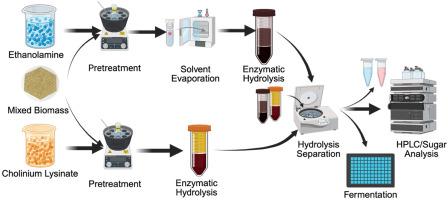Comparison of the efficacy of a biocompatible and a distillable solvent for pretreatment of mixed bioenergy feedstocks
IF 5.8
2区 生物学
Q1 AGRICULTURAL ENGINEERING
引用次数: 0
Abstract
Biomass deconstruction is a crucial step in the production of lignocellulosic biofuels and bioproducts. However, identifying and selecting an optimal pretreatment solvent that enhances enzymatic saccharification while being cost-efficient and ensuring sustainability remains a challenge. In this study, we compare the effectiveness of the biocompatible ionic liquid cholinium lysinate ([Ch][Lys]) against the distillable solvent ethanolamine, when used for the pretreatment of mixed bioenergy feedstocks, including poplar, switchgrass, and sorghum. [Ch][Lys] was used at a concentration of 10 % wt. in a one-pot configuration without biomass washing and ethanolamine was used in a concentrated form and removed with a vacuum oven, before performing enzymatic hydrolysis and microbial conversion. Our results show that ethanolamine pretreatment consistently enhances the glucose yield across various biomass types compared to [Ch][Lys], with improvements ranging from 22.0 % to 52.7 %. The highest combined sugar release was observed when the three feedstocks were combined in equal amounts and pretreated with ethanolamine, achieving a glucose yield of 84.6 % and a xylose yield of 76.6 %. Additionally, ethanolamine exhibited exceptional solvent recovery efficiency, with removal efficiencies exceeding 99.8 % at 120 °C across all feedstocks, highlighting its advantage over non-distillable solvents. While both solvents produced biocompatible hydrolysates, the hydrolysates prepared using ethanolamine resulted in higher bioproduct formation. These findings highlight the industrial relevance of selecting recyclable and biocompatible solvents for scalable, sustainable, and cost-effective bioenergy production. This study contributes to the development of economically viable and scalable pretreatment technologies for bioenergy applications using different feedstocks and process configurations.

生物相容性溶剂和可蒸馏溶剂预处理混合生物能源原料的效果比较
生物质分解是生产木质纤维素生物燃料和生物产品的关键步骤。然而,确定和选择一种最佳的预处理溶剂,既能提高酶糖化效率,又能保证成本效益和可持续性,仍然是一个挑战。在这项研究中,我们比较了生物相容性离子液体赖氨酸胆碱([Ch][Lys])与可蒸馏溶剂乙醇胺在预处理混合生物能源原料(包括杨树、柳枝稷和高粱)时的效果。[Ch][Lys]以10% wt的浓度在一锅配置中使用,不进行生物质洗涤,乙醇胺以浓缩形式使用,在进行酶水解和微生物转化之前用真空烘箱除去。我们的研究结果表明,与[Ch][Lys]相比,乙醇胺预处理持续提高了各种生物质类型的葡萄糖产量,提高幅度从22.0%到52.7%不等。当三种原料等量混合并经乙醇胺预处理时,糖的联合释放量最高,葡萄糖收率为84.6%,木糖收率为76.6%。此外,乙醇胺表现出优异的溶剂回收效率,在120°C下对所有原料的去除率超过99.8%,突出了其相对于不可蒸馏溶剂的优势。虽然这两种溶剂都产生了生物相容性的水解产物,但使用乙醇胺制备的水解产物产生了更高的生物产物。这些发现强调了选择可回收和生物相容性溶剂的工业相关性,以实现可扩展,可持续和具有成本效益的生物能源生产。这项研究有助于开发经济上可行和可扩展的预处理技术,用于使用不同的原料和工艺配置的生物能源应用。
本文章由计算机程序翻译,如有差异,请以英文原文为准。
求助全文
约1分钟内获得全文
求助全文
来源期刊

Biomass & Bioenergy
工程技术-能源与燃料
CiteScore
11.50
自引率
3.30%
发文量
258
审稿时长
60 days
期刊介绍:
Biomass & Bioenergy is an international journal publishing original research papers and short communications, review articles and case studies on biological resources, chemical and biological processes, and biomass products for new renewable sources of energy and materials.
The scope of the journal extends to the environmental, management and economic aspects of biomass and bioenergy.
Key areas covered by the journal:
• Biomass: sources, energy crop production processes, genetic improvements, composition. Please note that research on these biomass subjects must be linked directly to bioenergy generation.
• Biological Residues: residues/rests from agricultural production, forestry and plantations (palm, sugar etc), processing industries, and municipal sources (MSW). Papers on the use of biomass residues through innovative processes/technological novelty and/or consideration of feedstock/system sustainability (or unsustainability) are welcomed. However waste treatment processes and pollution control or mitigation which are only tangentially related to bioenergy are not in the scope of the journal, as they are more suited to publications in the environmental arena. Papers that describe conventional waste streams (ie well described in existing literature) that do not empirically address ''new'' added value from the process are not suitable for submission to the journal.
• Bioenergy Processes: fermentations, thermochemical conversions, liquid and gaseous fuels, and petrochemical substitutes
• Bioenergy Utilization: direct combustion, gasification, electricity production, chemical processes, and by-product remediation
• Biomass and the Environment: carbon cycle, the net energy efficiency of bioenergy systems, assessment of sustainability, and biodiversity issues.
 求助内容:
求助内容: 应助结果提醒方式:
应助结果提醒方式:


